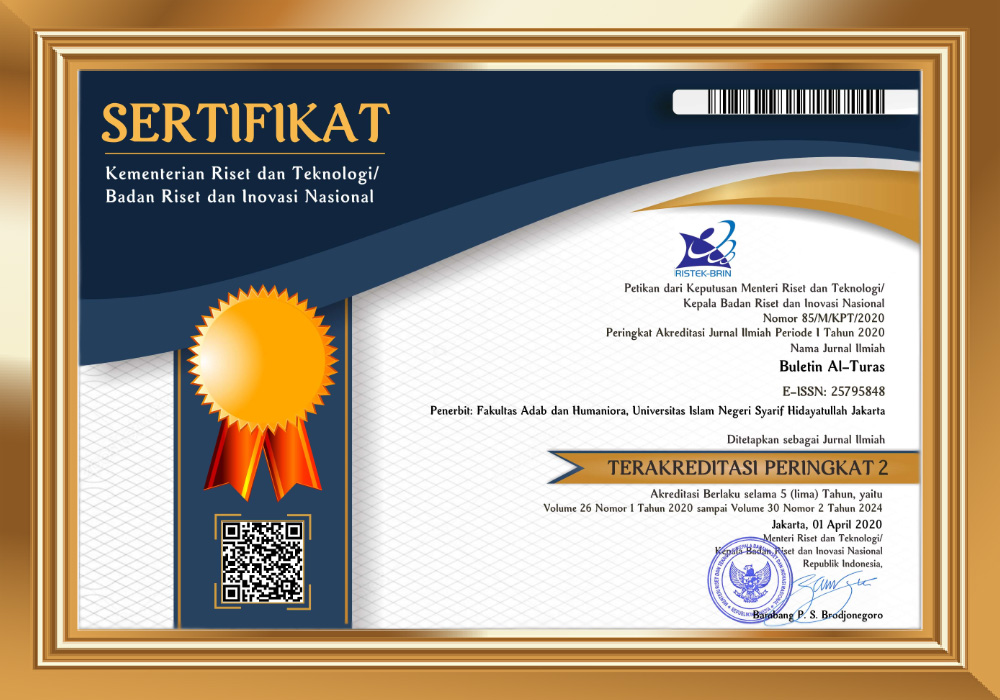Abjection towards Women by Tribes and the State in the Niduparas Erlang’s Burung Kayu
Abstract
Purpose
This research aimed to reveal the process of abjection experienced by women by the tribes and the state with its developmentalism ideology in the Burung Kayu by Niduparas Erlang. It also explores the implications of these two regimes, which ultimately contribute to women’s abjection.
Method
This research employed notetaking and literature review techniques for collecting the data. Linguistic data depicting abjection in the novel were interpreted by the researcher according to Julia Kristeva’s theory of abjection. The analysis was supplemented with findings from previous research.
Results/findings
This research presented several findings. Women experienced abjection because the Mentawai tribe practiced a paternalistic culture. This culture reinforced abjection towards women, especially when state intervention with developmentalism ideology was introduced. This development did not provide opportunities for women. Women were abjected as they adhere to their husbands’ will, rather than their own desires. This research sheded light on the fact that although the tribal and state regimes might seem contradictory, they fundamentally reinforce each other in positioning women as abject.
Conclusion
This research concluded that abjection was multidimensional, as gender intersected with tribal and state elements supported by developmentalism ideology.
Keywords
References
Aji, A. N., Mujtaba, S., & Adham, M. J. I. (2021). Analisis Kearifan Lokal dalam Novel Burung Kayu Karya Nidurparas Erlang dan Relavansinya sebagai Bahan Ajar Sekolah Menengah Atas. Edukatif: Jurnal Ilmu Pendidikan, 3(5), 3318–3331. https://doi.org/10.31004/edukatif.v3i5.1239.
Bakker, L. (2007). Foreign images in Mentawai authenticity and the exotic. Bijdragen Tot de Taal-, Land- En Volkenkunde, 163(2–3), 263–288. https://doi.org/10.1163/22134379-90003686.
Beghetto, R. G. (2022). Monstrous Liminality; Or, The Uncanny Strangers of Secularized Modernity. ubiquity press.
Candraningrum, D. (2020). Pemberontakan Linguistik Kristeva: Perempuan sebagai Liyan dalam Politik Bahasa. In W. Udasmoro (Ed.), Gerak Kuasa: Politik Wacana, Identitas, dan Ruang/Waktu dalam Bingkai Kajian Budaya dan Media (pp. 87–112). Kepustakaan Populer Gramedia.
Condren, M. (1999). Women, shame and abjection: reflections in the light of Julia Kristeva. Contact, 130(1), 10–19.
Darmanto, & Setyawati, A. B. (2012). Berebut Hutan Siberut: Orang Mentawai, Kekuasaan, dan Politik Ekologi. Kepustakaan Populer Gramedia bekerja sama dengan UNESCO.
Delfi, M. (2013a). Islam and Arat Sabulungan in Mentawai. Al-Jami’ah, 51(2), 475–499. https://doi.org/10.14421/ajis.2013.512.475-499.
Delfi, M. (2013b). Contemporary Mentawai Recapitulates Ancestry: The Position of Women in Siberut Society. Humaniora, 25(1), 14–24.
Eindhoven, M. (2007). New colonizers? Identity, representation and government in the post-New Order Mentawai Archipelago. In H. S. Nordholt & G. van Klinken (Eds.), Renegotiating Boundaries: Local Politics in Post-Suharto Indonesia (pp. 67–90). KITLV Press. https://doi.org/10.1163/j.ctt1w76x39.9.
Erlang, N. (2023). Burung Kayu. Teroka Press.
Faruk. (2018). Nasionalisme Puitis: Sastra, Politik, dan Kajian Budaya. Pustaka Pelajar.
Gerung, R. (2024). Obat Dungu Resep Akal Sehat: Filsafat untuk Republik Kuat. Komunitas Bambu.
Hammons, C. S. (2016). Indigenous Religion, Christianity and the State: Mobility and Nomadic Metaphysics in Siberut, Western Indonesia. Asia Pacific Journal of Anthropology, 17(5), 399–418. https://doi.org/10.1080/14442213.2016.1208676.
Irwandi, A., & Saleleubaja, K. I. (2021). Dari Sagu ke Beras: Perubahan Kehidupan Sosial Budaya Orang Mentawai. Jurnal Masyarakat Indonesia, 47(2), 195–206. http://jmi.ipsk.lipi.go.id.
Jacobson, M., & Larsen, S. C. (2014). Ethnographic fiction for writing and research in cultural geography. Journal of Cultural Geography, 31(2), 179–193. https://doi.org/10.1080/08873631.2014.906851.
Kristeva, J. (1982). Powers of Horror: An Essay on Abjection. Columbia University Press.
Nurjanah, K., Meliasanti, F., & Sutri, S. (2022). Warna Lokal Mentawai dalam Novel Burung Kayu Karya Niduparas Erlang dan Pemanfaatannya sebagai Materi Ajar. Jurnal Educatio FKIP UNMA, 8(1), 164–173. https://doi.org/10.31949/educatio.v8i1.1833.
Olsen, T.A. (2018) This Word is (Not?) Very Exciting: Considering Intersectionality in Indigenous Studies. NORA - Nordic Journal of Feminist and Gender Research, 26(3), 182–196, DOI: 10.1080/08038740.2018.1493534.
Persoon, G. (1998). Isolated Groups or Indigenous Peoples: Indonesia and the International Discourse. Bijdragen tot de Taal-, Land- en Volkenkunde, 154(2), 281–304.
Pickard, S. (2019). On becoming a hag: gender, ageing and abjection. Feminist Theory, 146470011985975. doi:10.1177/1464700119859.
Rak, J. (2018). Theorizing Cultures of Political Violence in Times of Austerity Studying Social Movements in Comparative Perspective. Routledge.
Santoso, W. M. (2016). Penelitian dan Pengarusutamaan Gender: Sebuah Pengantar. LIPI Press.
Savage, M., & Schmidt, C. M. (2020). The politics of the excluded: abjection and reconciliation amongst the British precariat. The Journal of Chinese Sociology, 7(23), 1–27. https://doi.org/10.1186/s40711-020-00134-7.
Schefold, R. (1982). The Efficacious Symbol. In P. E. de Josselin de Jong & E. Schwimmer (Eds.), Symbolic anthropology in the Netherlands (pp. 125–141). Martinus Nijhoff.
Singh, M., Kaptchuk, T. J., & Henrich, J. (2021). Small gods, rituals, and cooperation: The Mentawai water spirit Sikameinan. Evolution and Human Behavior, 42(1), 61–72. https://doi.org/10.1016/j.evolhumbehav.2020.07.008.
Sjöholm, C. (2005). Kristeva and the Political. Routledge.
Tesar, M., & Arndt, S. (2020). Writing the Human “I”: Liminal Spaces of Mundane Abjection. Qualitative Inquiry, 26(8–9), 1102–1109. https://doi.org/10.1177/1077800419881656.
Wahyuni, D., Busro, B., Sabna, A., & Karista, K. (2023). Resistensi Arat Sabulungan terhadap Modernisasi: Analisis Kritis atas Novel Burung Kayu Karya Niduparas Erlang. Temali: Jurnal Pembangunan Sosial, 6(1), 79–88. https://doi.org/10.15575/jt.v6i1.25670.
Windiyarti, D. (2021). Novel Burung Kayu Karya Niduparas Erlang: Representasi Budaya Masyarakat Tradisional Suku Mentawai yang Terkoyak. Sirok Bastra, Desember, 9(2), 167–184.
DOI: 10.15408/bat.v31i1.41286
Refbacks
- There are currently no refbacks.
Copyright (c) 2025 Cahyaningrum Dewojati, Riqko Nur Ardi Windayanto

This work is licensed under a Creative Commons Attribution-ShareAlike 4.0 International License.






